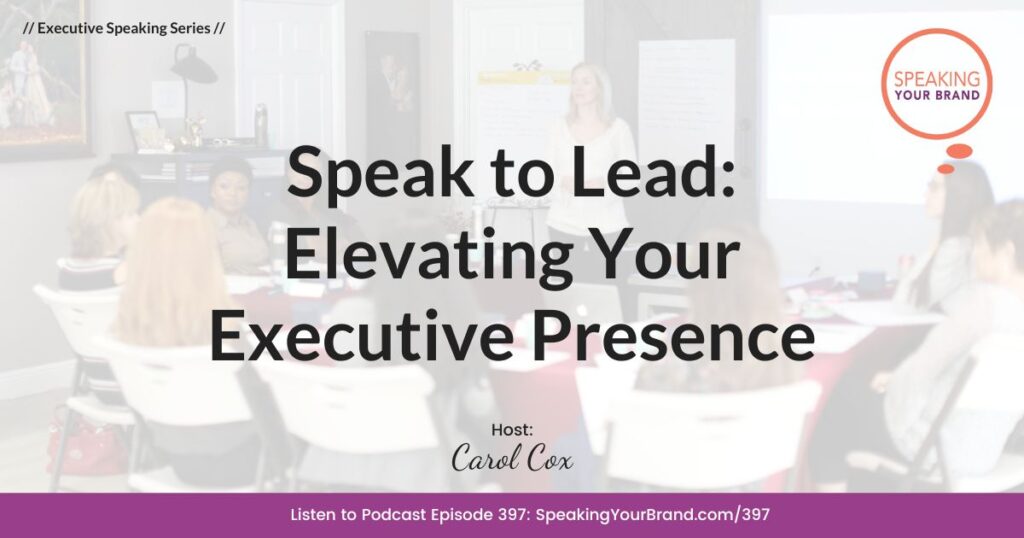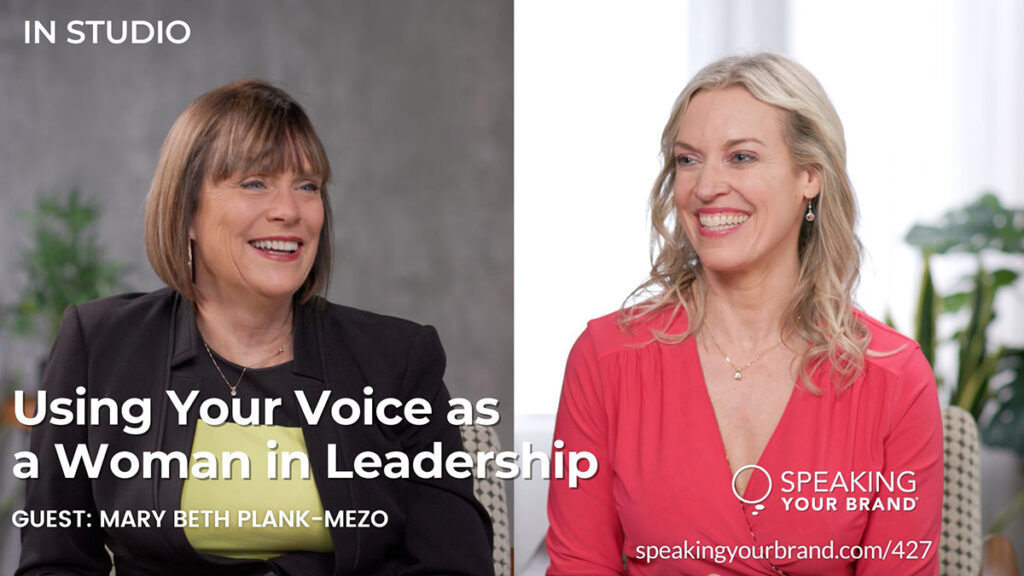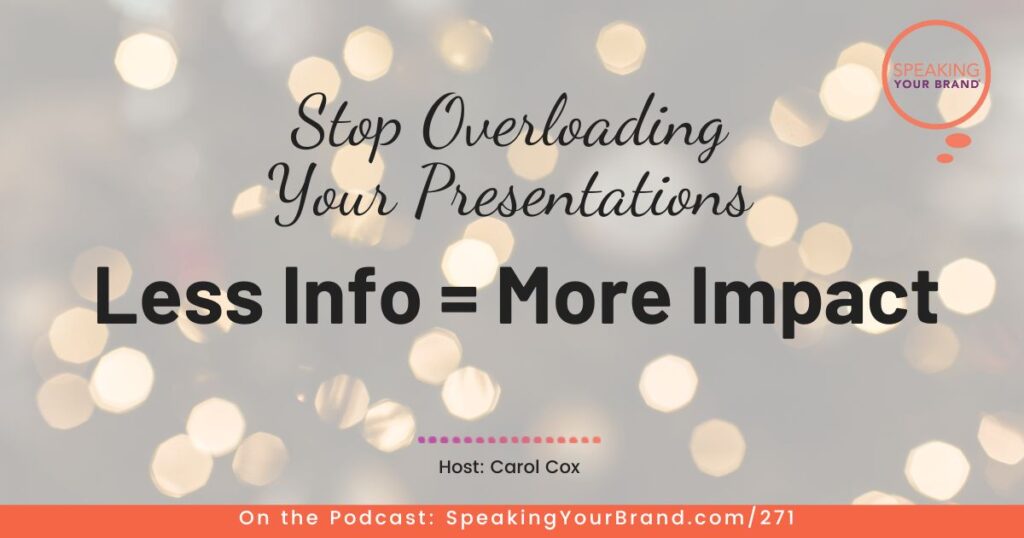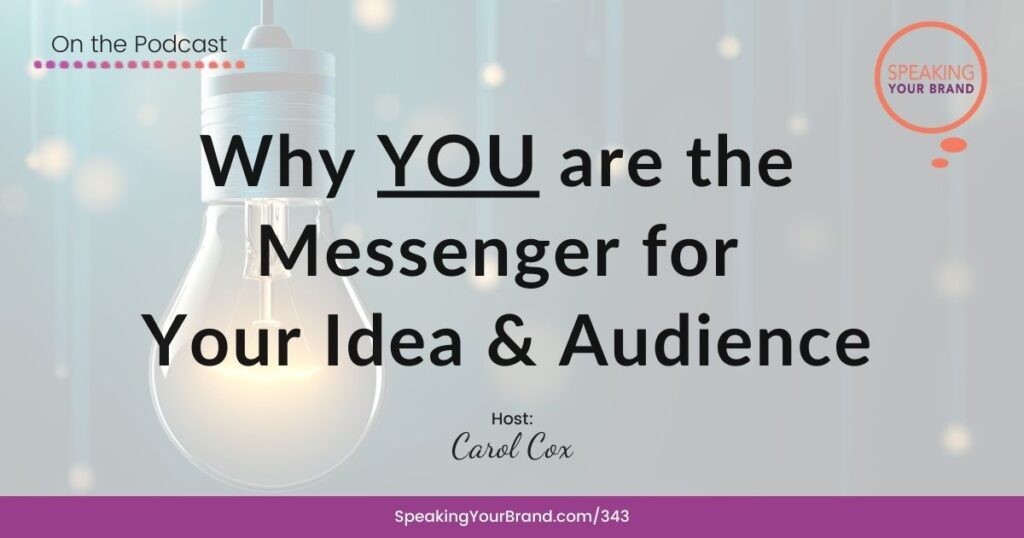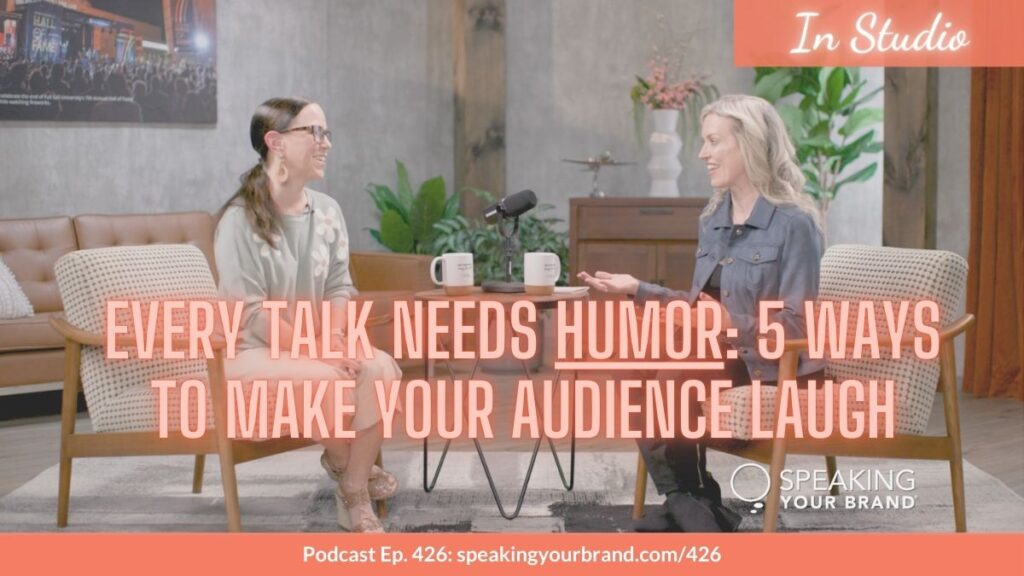397-SYB-Solo-Executive-Presence.mp3: this mp3 audio file was automatically transcribed by Sonix with the best speech-to-text algorithms. This transcript may contain errors.
Carol Cox:
What exactly is executive presence and why do you need it? That’s what we’re talking about on this episode of the Speaking Your Brand podcast. More and more women are making an impact by starting businesses, running for office and speaking up for what matters. With my background as a TV political analyst, entrepreneur and speaker, I interview and coach purpose driven women to shape their brands, grow their companies, and become recognized as influencers in their field. This is speaking your brand, your place to learn how to persuasively communicate your message to your audience. Welcome to the Speaking Your Brand podcast. I’m your host, Carol Cox. Have you ever been captivated by a speaker who seems to effortlessly command the room, inspiring everyone with their words and presence? That’s the magic of executive presence combined with powerful public speaking. Whether you’re leading a team or an organization or a workshop, either internally or externally, whether you’re presenting to 20 people, 200 people or 2000 people, your ability to communicate your ideas clearly, get buy in from your audience and deliver with energy and confidence can make all the difference. But here’s the thing executive presence doesn’t just come about overnight, nor is it the exclusive domain of the naturally charismatic, which is what we think that it is. It’s an art that can be cultivated, and one of the most powerful tools for doing so is honing your presentation and storytelling skills. That’s why we’re doing this brand new podcast series all around executive speaking.
Carol Cox:
We’re going to explore how you can elevate your executive presence through impactful communication. If you work at a company and are looking to enhance your leadership skills, this series is meant for you. Now, if you’re an entrepreneur and I know for many of you who are listening, you are entrepreneurs, you’re also going to get a lot out of this series by learning how to effectively convey your vision and inspire your team, as well as your other audiences. I’m going to share with you some things that you can think about regarding executive presence. And I’m also going to share about a speaking workshop we recently held for women who are running for office, what we saw and what they learned, which I know is going to help you as well. If you’re new to the Speaking Your Brand podcast, I’m so glad that you’re here. We work with women entrepreneurs, professionals, and leaders to clarify their brand message and story, create their signature talks, and develop their thought leadership platforms. Through our proven framework, we’ve empowered countless women to step into their power and make their voices heard. We know that we want to see more women in positions of influence on boards, on leadership teams, in business and in politics. Executive presence matters. For that to happen. Before we dive into the main part of this episode, I invite you to take our free speaker Archetype quiz as speaking your Brand.com slash quiz.
Carol Cox:
This quiz will help you to discover your unique speaking and communication style, and how you can leverage it to enhance your speaking and your executive presence. It only takes a few minutes to take the quiz. It’s ten fun multiple choice questions. Again, go ahead and pause right now. Go take the quiz at speaking your brand.com/quiz. Get your results and then come back and listen. Now let’s get on with the show. Have you ever found yourself delivering a presentation, especially in presentation internally at work, or say at an industry conference or even an academic conference and it’s packed with data, or it’s packed with information only to see your audience’s eyes glaze over? Or even worse, they start picking up their phone, or maybe they even leave the room. Or have you ever found yourself delivering a meeting and you’re going through item and item on the agenda, but you’ve lost the rest of the team members. Not only have you lost their attention, but you’ve also lost their enthusiasm. Or on the flip side, have you been an attendee at a meeting and thinking to yourself, well, this could have been an email. The person leading the meeting is just passing along information, maybe answering questions from a few people. And that’s it. These are classic examples of falling into what I call the expert trap. So what is missing in these examples? Well, the first thing is that the person presenting the information, whether it’s to an audience externally or in a meeting internally, what’s missing is getting buy in from the people there by painting a picture of the bigger vision, the bigger why? Also engaging the audience very intentionally and deliberately throughout and sharing personal stories, creating an emotional connection.
Carol Cox:
And I know for so many of you, when you think about personal storytelling and business, they do not go hand in hand. It feels like oil and water. But as we’re going to talk about a little bit in this episode, but much more in next week’s episode, sharing personal stories. Especially in a professional or business or academic environment, is more important than ever. As leaders, we have a wealth of knowledge and we have a wealth of expertise and insights. And of course we want to share it. However, too much information can overwhelm your audience and dilute your message and therefore lessen your impact. This idea of the expert trap is when you focus so much on showcasing your expertise by delivering an overload of information that you miss the opportunities to provide your audience not only with insight, but also with transformation. It’s not just about the data, it’s about what that data is going to do for them. After all, your goal as a speaker or as the person leading the team is to inspire action and change not just to inform, not just to pass along information. Transformation is about creating a meaningful impact. It’s the difference between knowing something and actually being motivated to act on that knowledge.
Carol Cox:
I know for so many of you who are going out there speaking to audiences, whether it’s at lunch and learns business conferences or industry association groups, that not only do you want your audience to learn something, but you want them to act on that knowledge. And that’s where this transformation piece comes in. If you are in corporate and you’re at an executive or manager level, your ability to drive transformation through your words can significantly influence your organization’s and your team’s success. So how can we do this? How can we escape the expert trap, especially when we’re thinking about executive presence? And especially for those of you who do work in corporate. So here are things that you can do. The first thing is simplify your message. Cut, cut and cut some more. I know it’s so hard to think about it because you and you know, and you’re and you’re probably right that all of the things that you want to convey, all of the information is really important. And it probably is really important. But your audience can only handle so much information at a time. So think about can some of this information be sent as an email or be sent as a document, something in some other medium, not just through speaking to them as an audience or in that team meeting? So focus on the key points that will resonate most with your audience.
Carol Cox:
What do they need to know to understand what you’re sharing with them, to understand that bigger vision and those ideas that you’re sharing? And not only that, but what do they need to know to actually act on your message? I think that’s so important to really think about, not just the understanding, but also the action. So simplify your message. This is why here at Speaking Your Brand, we love working on those ten minutes Ted style talks, because it is such a creative challenge to distill a message into only ten minutes. But here’s the thing. I find those ten minute talks to be just as effective, if not more effective, than a 30 minute or 45 minute talk. That’s why one of the things that we do in our Thought Leader Academy is that the clients work with us to create their signature talk in that one on one VIP day, and then they work to flesh out the talk, and they actually practice delivering it in our group zoom calls during the Thought Leader Academy. And then we have them create a ten minute version of their talk, and they deliver it on a LinkedIn live. And we’ve done that. Some of these recently. I’ll include links to the show notes, but if you scroll back in your podcast feed, find the ones where it says like live signature talks from our Thought Leader Academy grads, and you can hear their ten minute versions. The second thing to do to escape the expert trap is highlight the impact of your message.
Carol Cox:
So instead of drowning your audience in details in a minutia, again, save that for a document or for an email. Emphasize the impact of your ideas and the benefits of your message. How will your proposal or your insight change their situation for the better? I really want you to get into the heads of the people that you’re talking to again, whether it’s your team, its executives that you’re presenting to, or it’s a larger audience, what does that audience want? Validate what that particular audience wants and how you can find a common vision. What are their goals? What are those obstacles standing in the way? And how could your proposed idea or the insight that you’re sharing? How can it change their situation for the better? Really find that common ground with them? The third thing is engage with your audience. And I know you already know this. Ask questions whether it’s show of hands questions or questions that they can answer out loud. Invite participation. It really creates an interactive experience, but it also shows your audience that you care. You care about hearing what they think, what they think about those ideas, other things that they have to contribute as well. Instead of them being passive, which is where they lose focus, they lose attention and they lose enthusiasm instead, get their input and their buy in along the way. The fourth thing to do is to connect emotionally.
Carol Cox:
And I know again, it feels very counterintuitive to do this in a business or professional or academic environment, but sharing stories that resonate emotionally with your audience can make such a huge difference. When people feel connected to your message and they find their connection to your message, that’s when they’re more likely to be inspired and motivated to act. And we’re going to talk a lot more about storytelling for leaders in next week’s episode. So finally, always include a clear call to action. What do you want your audience or your team to do? Make it specific and make it actionable so that there is no guessing what you want them to do. Let’s recap now what you can do to escape the expert trap and focus on transformation rather than just information. The first thing simplify your message. Focus on those key points that are going to get your audience to act. Highlight the impact. Validate what that audience wants and how you can find that common vision. Number three engage with your audience. Number four connect emotionally. And five always include that very specific call to action. We recently hosted an in-person speaking workshop for some women who are running for office here in the Central Florida Orlando area. So these are Democratic, pro-choice women who are running from everywhere, from U.S. Congress to state House and state Senate, county Commission, and so on. And it was so fun to be with them.
Carol Cox:
We were there for about 2.5 hours, and so we brought them in. We had our workbooks so that they could work on some things, but one of the things that I asked them towards the very beginning was not only what did they want to get out of the workshop, but I asked them how they wanted to feel when they were speaking to their audiences, whether they were speaking to warm audiences so people who were likely to support them, or maybe they were speaking to mixed audiences and they weren’t sure who was in the audience. How do they want to feel? And what was so fascinating was that all of them talked about. Stuff in their head. They talked about information. They completely missed how they wanted to feel in their bodies. And this is why, if you’ve been listening to this podcast, especially for the past year or so, I’ve been talking a lot more about not only just the information we’re conveying to our audience. Again, that expertise and those insights that are in our head, but how we feel in our bodies and how we’re energetically conveying that to our audiences. And at the speaking workshop for these women political candidates, we also talked about taking up space. So literally taking up space. As women, we are often brought up and socialized to be smaller, so we kind of scooch in to have let someone have room to sit next to us, or we oftentimes get small also, so that we’re not we’re not as visible.
Carol Cox:
Sometimes it’s a safety and a protection mechanism, but these messages get subconsciously reinforced over all of these years, so we’re less likely to take up space. So we don’t take up space with our arms or our legs. We don’t move around the room or move around the stage as much as we should. So at this workshop and at our in-person retreats, we always have a dance parties and half of the women love it. Half of the women groan about it because, you know, they feel embarrassed or they feel self-conscious, and that’s why we make them do it. So we put on some fun music with a good beat, some popular songs, and we just dance around and we make everyone dance around. Use the whole room, use space, use our arms up above our heads, really get into it and have fun. This is the same reason we do improv activities at our in-person workshops and retreats. Also, yoga is a really good thing to do to get more into your body as well. And also thinking about meditation and visualization exercises so that you can get more in touch with your breath and with how your body is feeling. So again at the speaking workshop. So not only did we talk a lot about taking up space and how we wanted to feel in our bodies and using our bodies, but we also talked about those things that I just listed above, simplifying their message, highlighting the impact, validating what that particular audience wants and how you can find common ground and a common vision.
Carol Cox:
And of course, leading with story. Oh my gosh, when we had the women change their stump speech to lead with a very specific and very personal and emotional story. Wow. You could feel the difference in the energy of the room once they change that. And again, we’ll talk more about that in next week’s episode. Executive presence, I hope you can see now isn’t an innate quality. It’s not that, oh, that person was born that way, or that person is just charismatic. It’s a skill that can be developed and refined, especially through consistent public speaking. By focusing on transformation and not just information, by understanding your audience and engaging with them, by using storytelling and by mastering body language and taking up space, you can enhance your executive presence and become the speaker and the leader you aspire to be. Don’t forget to take our free speaker Archetype quiz. You’ll discover what your speaker archetype is so you can leverage your natural communication strengths and then add to them to make you an even more dynamic speaker. You can take that quiz as speaking your Brand.com slash quiz. If you’ve enjoyed this episode, share it with a friend or colleague who you think would get a lot of value out of it. Until next time, thanks for listening.
Sonix has many features that you’d love including automatic transcription software, automated translation, automated subtitles, transcribe multiple languages, and easily transcribe your Zoom meetings. Try Sonix for free today.

